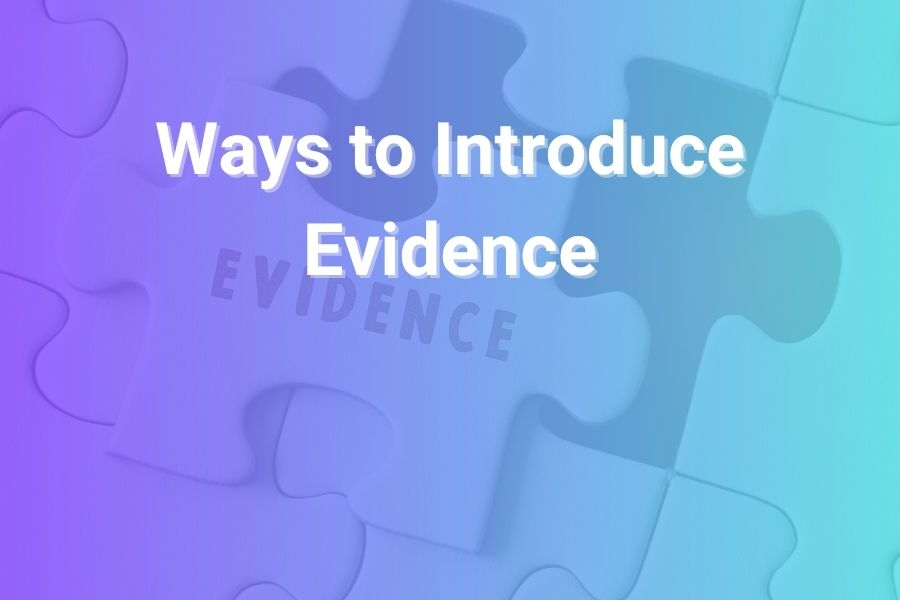Every strong argument relies on proof. Evidence transforms an opinion into a convincing claim that readers can trust. Whether you’re writing an essay, report, or research paper, how you introduce that evidence determines whether it persuades or confuses.
The right phrasing bridges your idea with your supporting facts, making your writing sound logical and credible. Learning to present evidence smoothly also improves flow, coherence, and reader engagement. In this article, you’ll learn how to introduce evidence clearly, the most effective transition phrases to use, and techniques professionals apply to make evidence sound persuasive and natural.
Understanding the Role of Evidence in Writing
Evidence gives weight to your argument. It validates your viewpoint and demonstrates that your conclusions are based on research or factual information. When readers see credible data or quotations smoothly integrated into your text, they perceive you as informed and trustworthy. Introducing evidence poorly, however, can make writing sound awkward or forced.
Good evidence introduction starts with understanding purpose. Evidence isn’t decoration; it connects directly to your thesis and strengthens each paragraph’s claim. It can take many forms—statistics, expert opinions, examples, or case studies—but every piece of evidence must relate clearly to the argument you’re making.
Why the Way You Introduce Evidence Matters
Even solid research can fall flat if it’s dropped into writing without context. Think of your writing as a guided conversation: you don’t just throw numbers at someone, you explain why they matter. When you lead into evidence thoughtfully, readers understand what to expect and why the information supports your idea.
Effective introductions to evidence also keep your writing smooth and cohesive. They prevent abrupt shifts that confuse readers. Academic writing thrives on clarity, so transition words and contextual phrases act like bridges—helping the reader move from one idea to another effortlessly.
Types of Evidence to Introduce
Writers often use different evidence types, each requiring its own introduction strategy:
- Statistical Evidence – Numbers and data that show measurable proof. Example: survey results, charts, or research statistics.
- Expert Testimony – Insights from professionals or scholars in the field. These add authority and credibility.
- Anecdotal or Observational Evidence – Real-life examples or personal experiences that illustrate a broader point.
- Textual Evidence – Direct quotes or paraphrased content from written sources like books or articles.
- Empirical Evidence – Information derived from experiments or fieldwork.
Each type must be introduced in a way that matches its purpose and tone. For instance, statistics benefit from analytical phrasing (“Recent data shows that…”), while expert quotes need attribution (“According to Dr. Smith…”).
How to Introduce Evidence Smoothly
The introduction of evidence typically follows a simple pattern: introduce, present, and explain. This three-step flow ensures readers understand what the evidence means instead of being left to interpret it on their own.
- Set Up the Context – Before presenting evidence, clarify what point it supports.
- Introduce the Source or Type of Evidence – Use a phrase that signals where the information comes from.
- Explain Its Relevance – After presenting the evidence, connect it back to your main argument.
For example:
Recent research from the Pew Research Center reveals that over 65% of U.S. adults rely on digital news sources. This trend highlights how media habits continue to shift toward online platforms, reinforcing the argument that print readership is in decline.
This example shows how a statistic is framed, presented, and linked to the essay’s focus.
Common Phrases for Introducing Evidence
Strong transitions are key. Below are commonly used introductory phrases that signal the start of evidence and clarify its purpose:
- According to recent studies…
- Research conducted by…
- Data from the U.S. Bureau of Labor Statistics reveals that…
- As demonstrated by previous findings…
- Experts in the field argue that…
- A 2024 survey found that…
- Evidence suggests that…
- One example that illustrates this point is…
- The results indicate that…
- This supports the claim that…
Each phrase helps maintain logical flow while giving the reader confidence in the validity of your claims.
Choosing the Right Transition Words
Transition words are small, but they make a big difference. They guide the reader through your reasoning and signal how each piece of information connects to the next. Depending on the function, you can use different categories of transitions:
- To introduce examples: for instance, for example, such as, including
- To emphasize evidence: indeed, notably, in fact, clearly
- To show contrast: however, on the other hand, yet, still
- To conclude evidence: therefore, consequently, as a result, thus
The right transitions ensure that your paragraphs don’t feel like a list of facts. Instead, they form a chain of reasoning.
Using Expert Opinions as Evidence
Quoting or paraphrasing experts adds credibility and depth. But the introduction must do more than drop a name. You should explain why that expert matters. Example:
According to linguistics professor Deborah Tannen, conversational style reflects cultural norms more than individual personality. Her insight clarifies why miscommunication often occurs between groups with different linguistic traditions.
Here, the introduction not only attributes the evidence but also frames the expert’s relevance.
Integrating Statistical Evidence with Clarity
Statistics are powerful, but raw numbers can lose impact if they aren’t framed. Introduce them with a clear setup:
Recent U.S. Census Bureau data from 2024 shows that remote work increased by 18% over the previous year, reflecting the long-term shift in employment patterns.
This approach signals what the reader should notice and connects numbers to meaning. Always mention the data source to reinforce credibility.
Introducing Evidence in Research Writing
Academic papers demand a structured and formal tone. Evidence should appear naturally within this framework, not as afterthoughts. Each paragraph ideally follows this pattern:
- Topic sentence introducing the main idea
- Context or setup for the evidence
- The evidence itself (quote, statistic, or data)
- Analysis linking evidence to argument
For example:
Climate change research consistently links global temperature increases to carbon emissions. A 2023 NASA report states that Earth’s average temperature has risen by 1.2°C since the late 19th century. This supports the claim that human activity continues to drive significant environmental change.
This method keeps your evidence anchored in logic and maintains academic integrity.
Avoiding Common Mistakes When Introducing Evidence
Writers sometimes weaken their argument by mishandling evidence. The most frequent errors include:
- Dropping evidence without context – Readers need to know why it matters.
- Overusing quotations – Too many direct quotes make writing sound borrowed rather than original.
- Failing to analyze evidence – Presenting data without interpretation leaves the argument unfinished.
- Using unreliable sources – Always ensure credibility. Academic writing depends on trust.
Building Flow and Coherence
To make evidence flow naturally, writers must think about coherence between sentences. Each sentence should connect to the next in meaning and tone. Techniques to achieve this include:
- Using pronouns or synonyms to link ideas.
- Repeating key terms strategically for consistency.
- Placing transitions at the start of sentences to guide readers.
- Ending paragraphs by summarizing how the evidence advances your argument.
For instance: These findings reveal not only the importance of digital literacy but also the growing gap between users with unequal access to technology. This type of sentence connects back to your main theme while preparing the ground for the next idea.
When to Paraphrase vs. Quote Evidence
Deciding how to present evidence depends on emphasis.
- Quote directly when the wording is powerful or precise.
- Paraphrase when you want to integrate evidence smoothly without interrupting flow.
Example:
Original quote – “Social media shapes not only public opinion but also political outcomes.”
Paraphrased – Studies show that social media now influences both how people form opinions and how elections unfold.
The paraphrased version keeps meaning intact while fitting the writer’s tone.
Using Signal Phrases for Clarity
Signal phrases alert readers that evidence is coming. They often include verbs that indicate how the source relates to your idea. Examples include: argues, explains, reports, concludes, emphasizes, observes, finds, confirms, and illustrates.
Choosing the right verb shapes reader perception. For instance, “Smith argues that…” implies debate, while “Smith finds that…” suggests objective observation. The nuance strengthens credibility and keeps writing precise.
Balancing Your Own Voice with Evidence
Strong writing balances outside information with your interpretation. Evidence supports you; it doesn’t replace you. Each time you introduce evidence, follow up with your voice—your analysis, insight, or conclusion. This pattern helps maintain ownership of your argument.
For example:
According to the American Psychological Association, stress levels among U.S. adults rose by 12% in 2024. This rise underscores the increasing need for workplace wellness programs that address mental health proactively.
The analysis sentence ties evidence to purpose, keeping control of the argument.
Making Evidence Persuasive to a Modern Audience
In today’s information-heavy environment, readers value concise, trustworthy evidence. When introducing data, always reference up-to-date sources. For instance, current statistics on online learning or employment trends resonate more with a 2025 audience than older data.
Additionally, visual evidence—such as graphs or charts—can be referenced in text to enhance engagement. You might write, As shown in Figure 2, participation in online courses has doubled since 2020. Even when visuals aren’t included, describing data clearly helps readers imagine the trend.
Using Tone to Frame Evidence
Tone matters as much as structure. Neutral, confident phrasing strengthens your credibility. Avoid uncertain language like “maybe,” “it seems,” or “perhaps.” Instead, use assertive phrases: “The evidence demonstrates,” “Studies confirm,” or “The findings reveal.” This conveys authority without sounding biased.
Recent Data Highlights the Importance of Evidence Integration
Writing studies from 2024 show that papers using clear transition phrases scored up to 25% higher in coherence compared to those that didn’t. Another
from the Modern Language Association found that 72% of academic readers preferred writing that explicitly signals evidence through phrases such as “According to” or “Data shows.” These findings prove that the way you introduce evidence directly affects readability and credibility.
Practical Tips for Mastering Evidence Introduction
- Practice paraphrasing sources to fit your tone.
- Use at least one signal phrase per paragraph of evidence.
- Always connect evidence to your thesis before moving on.
- Check transitions between sentences to avoid abrupt shifts.
- Revise your draft to ensure that every piece of evidence supports the argument logically.
Final Thoughts on Introducing Evidence
Introducing evidence effectively turns a plain statement into a persuasive argument. The goal isn’t just to show that research exists, but to weave it into your reasoning so the reader sees a clear path from claim to proof.
Whether you’re writing for school, business, or publication, mastering this skill makes your writing more logical, trustworthy, and memorable. Strong evidence, introduced with precision, is what separates average writing from expert work.






